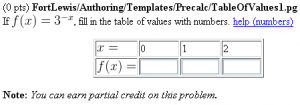Difference between revisions of "TableOfValues1"
Jump to navigation
Jump to search
Paultpearson (talk | contribs) m |
(add historical tag and give links to newer problems.) |
||
| (2 intermediate revisions by one other user not shown) | |||
| Line 1: | Line 1: | ||
| + | {{historical}} |
||
| + | |||
| + | <p style="font-size: 120%;font-weight:bold">This problem has been replaced with [https://openwebwork.github.io/pg-docs/sample-problems/Algebra/TableOfValues.html a newer version of this problem]</p> |
||
| + | |||
| + | |||
<h2>Fill in a Table of Values for a Function</h2> |
<h2>Fill in a Table of Values for a Function</h2> |
||
| Line 5: | Line 10: | ||
This PG code shows how to create a table with answer blanks in it. |
This PG code shows how to create a table with answer blanks in it. |
||
</p> |
</p> |
||
| − | * Download file: [[File:TableOfValues1.txt]] (change the file extension from txt to pg when you save it) |
||
| + | * File location in OPL: [https://github.com/openwebwork/webwork-open-problem-library/blob/master/OpenProblemLibrary/FortLewis/Authoring/Templates/Precalc/TableOfValues1.pg FortLewis/Authoring/Templates/Precalc/TableOfValues1.pg] |
||
| − | * File location in NPL: <code>FortLewis/Authoring/Templates/Precalc/TableOfValues1.pg</code> |
||
| + | * PGML location in OPL: [https://github.com/openwebwork/webwork-open-problem-library/blob/master/OpenProblemLibrary/FortLewis/Authoring/Templates/Precalc/TableOfValues1_PGML.pg FortLewis/Authoring/Templates/Precalc/TableOfValues1_PGML.pg] |
||
| − | |||
<br clear="all" /> |
<br clear="all" /> |
||
Latest revision as of 06:05, 18 July 2023
This problem has been replaced with a newer version of this problem
Fill in a Table of Values for a Function
This PG code shows how to create a table with answer blanks in it.
- File location in OPL: FortLewis/Authoring/Templates/Precalc/TableOfValues1.pg
- PGML location in OPL: FortLewis/Authoring/Templates/Precalc/TableOfValues1_PGML.pg
| PG problem file | Explanation |
|---|---|
|
Problem tagging: |
|
DOCUMENT(); loadMacros( "PGstandard.pl", "MathObjects.pl", "AnswerFormatHelp.pl", ); TEXT(beginproblem()); |
Initialization: |
Context("Numeric");
$f = Formula("3^(-x)");
@answer = ();
foreach my $i (0..2) {
$answer[$i] = $f->eval(x=>$i);
}
|
Setup:
We create an empty array |
Context()->texStrings;
BEGIN_TEXT
If \( f(x) = $f \), fill in the table of values with numbers.
\{ AnswerFormatHelp("numbers") \}
$PAR
$BCENTER
\{
begintable(5) .
row( "\(x = \)", "0", "1", "2" ) .
row( "\(f(x) = \)", ans_rule(5), ans_rule(5), ans_rule(5) ) .
endtable();
\}
$ECENTER
END_TEXT
Context()->normalStrings;
|
Main Text:
Notice that the table is inside a Perl code block |
$showPartialCorrectAnswers = 1;
foreach my $i (0..2) {
ANS( $answer[$i]->cmp() );
}
|
Answer Evaluation: |
Context()->texStrings;
BEGIN_SOLUTION
${PAR}SOLUTION:${PAR}
Solution explanation goes here.
END_SOLUTION
Context()->normalStrings;
COMMENT('MathObject version.');
ENDDOCUMENT();
|
Solution: |
